
Running an e-commerce business in New Zealand comes with unique challenges - like managing GST compliance, handling seasonal sales spikes, and juggling shipping logistics. Automation tools can help streamline these tasks, saving time and improving efficiency.
Here’s a quick look at 6 Shopify automation tools designed to make your life easier:
-
Shopify Magic: Free AI tools for product descriptions, image editing, and inventory alerts.
-
Build Your Store: Simplifies GST calculations and supports multi-currency pricing.
-
Intelis: Dynamic pricing and competitor analysis starting at US$39/month.
-
WISER: AI-powered recommendations to boost conversions by up to 20%. Free for stores with up to 50 orders/month.
-
Boost Commerce: Advanced search and merchandising features with plans starting at NZ$29/month.
-
Shopify Flow: Free workflow automation for repetitive tasks like inventory tracking and customer tagging.
Quick Comparison
| Tool | Key Features | Pricing (Monthly) | Best For |
|---|---|---|---|
| Shopify Magic | AI tools for descriptions, images | Free | All Shopify users |
| Build Your Store | GST handling, multi-currency support | Included in Shopify plans | NZ-specific compliance needs |
| Intelis | Dynamic pricing, competitor tracking | Starting at US$39 | Pricing strategies |
| WISER | AI recommendations, upselling | Free–NZ$399 | Boosting conversions |
| Boost Commerce | Personalised search, bundles | NZ$29–NZ$399 | Product discovery |
| Shopify Flow | Workflow automation | Free | Automating repetitive tasks |
These tools cater to various business needs, from marketing and pricing to inventory and customer engagement. Choose the one that fits your store’s size, budget, and operational challenges.
New! Shopify Automation Tools Overview | Save Time & Scale Your Store with Smart Automation!
1. Shopify Magic
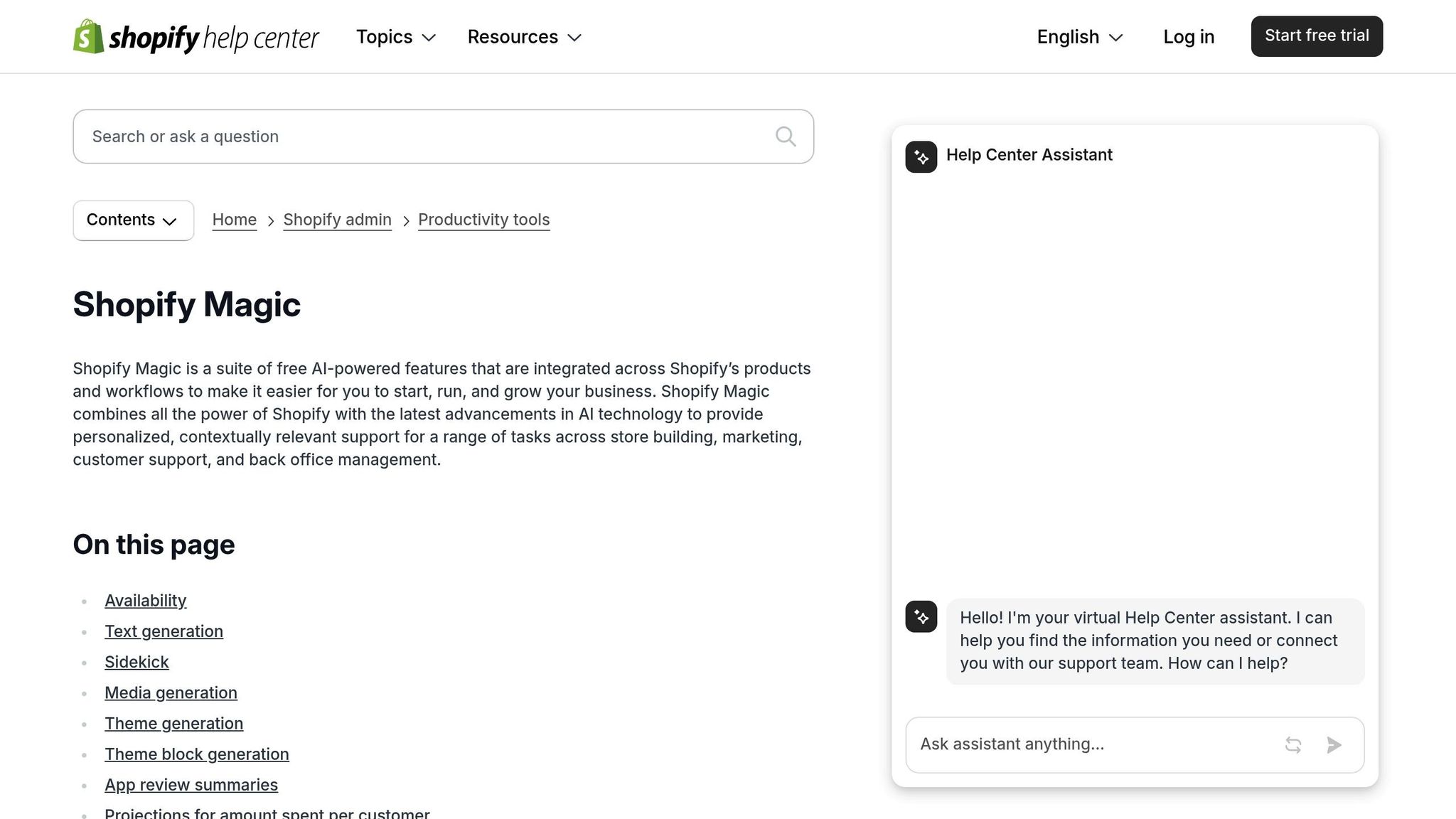
Shopify Magic is a suite of AI tools available at no extra cost to all Shopify merchants [3]. This accessibility is a game-changer for New Zealand businesses looking to simplify their operations and save time.
The platform tackles several key automation needs for Kiwi retailers. For example, its product description generator uses a few input keywords to create SEO-friendly content, making it easier for merchants to update their online stores - especially during busy periods like holiday sales [3].
Another standout feature is the image editing tool, which lets users change product backgrounds with just a few clicks. This allows merchants to create professional-quality images without investing in costly photography setups. It’s particularly handy for tailoring product visuals to suit different marketing campaigns [3].
Shopify Magic also includes Sidekick, an AI assistant designed to make data management easier. It can summarise business data, generate detailed reports, and deliver customised insights based on performance. For businesses managing inventory across multiple locations, Sidekick helps by flagging low or excess stock, reducing the risk of stockouts or overstocking [4].
Additionally, it works with Shopify Inbox to create personalised FAQ responses, providing better customer support during high-traffic times [3].
The platform's email marketing tool enhances campaigns by optimising send times and crafting attention-grabbing subject lines [2].
Finally, Shopify Magic integrates seamlessly with Shopify’s security features, ensuring data remains protected while automating routine tasks [5]. Up next, we’ll dive into Build Your Store to see how it stacks up.
2. Build Your Store
Shopify offers Kiwi merchants a range of features tailored to meet local needs, making it easier to establish and manage an online store.
Store Setup and Localisation
Setting up an online store in New Zealand can come with its own set of challenges, but Shopify simplifies the process with its built-in tools. For instance, the platform automatically handles GST calculations for New Zealand businesses [8], saving time and ensuring compliance. Merchants can also display prices inclusive of taxes, aligning with local customer expectations by showing the total cost upfront [9]. This streamlined setup also supports features like multi-currency pricing for broader reach.
Currency and International Reach
Shopify's multi-currency support, including NZD, is a game-changer for businesses aiming to attract global customers. With around 30% of site visitors coming from overseas and nearly half of potential buyers abandoning carts when local currency options aren’t available [9], having this flexibility is crucial for boosting sales and reducing cart abandonment.
Management and Automation Features
Shopify’s centralised admin panel is designed to make life easier for merchants. It integrates inventory management, order processing, and customer data into one accessible hub. Additionally, its mobile app and POS system seamlessly connect offline and online sales, allowing you to manage your store wherever you are [7].
Performance and Reliability
When it comes to performance, Shopify delivers. Its checkout process converts 15% more customers on average compared to other platforms, and its infrastructure ensures that stores are positioned within 50 milliseconds of shoppers worldwide [7]. On top of that, Shopify introduces over 150 new features every six months, ensuring merchants have access to the latest tools and updates [7].
3. Intelis
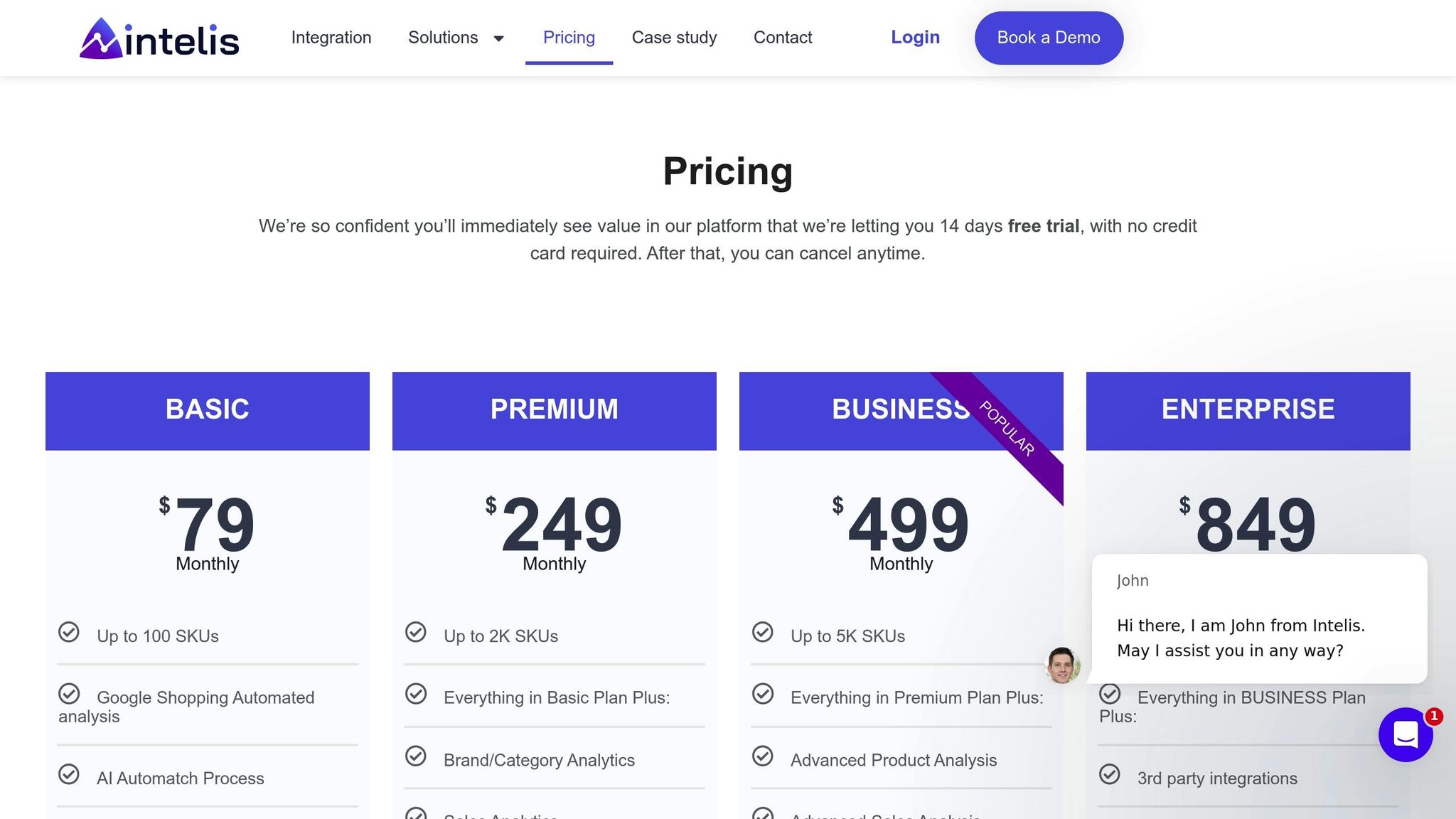
Intelis is a tool designed to help small and medium businesses fine-tune their pricing strategies while keeping tabs on competitors. Plans start at just US$39.00 per month, making it an accessible option for businesses looking to sharpen their competitive edge [10][11].
Dynamic Pricing and Market Intelligence
At its core, Intelis shines with its ability to adjust product prices automatically based on real-time market conditions and competitor data. It keeps a close watch on competitors across key sales channels, delivering timely market insights. For New Zealand merchants, this is a game-changer, helping them stay competitive both locally and on the global stage [11].
Features Tailored for New Zealand Businesses
Intelis offers a unified dashboard that’s especially handy for businesses operating in New Zealand. It tracks essential metrics like price trends, brand visibility, and category rankings. On top of that, it monitors daily orders, sales figures, and ensures adherence to Minimum Advertised Price (MAP) guidelines. These tools empower businesses to stay agile and adapt to shifting market demands [11][13].
Performance and User Feedback
Users have rated Intelis highly across the board, with an impressive 5.0-star rating for ease of use, customer service, and features. Its value for money also scores well, with a strong 4.8 out of 5 [10][11]. However, some users have pointed out minor drawbacks, such as limited mobile compatibility and occasional challenges in configuring pricing rules [10][11]. Despite these issues, the app’s intuitive design aligns with Shopify’s goal of delivering seamless automation.
Integration and Setup
Getting started with Intelis is simple. You can install it directly from the Shopify App Store. Once it’s up and running, you can configure it to monitor competitors and market trends relevant to your business. After setting pricing rules that match your goals, the system takes over, automatically adjusting prices to strike the perfect balance between increasing sales and maximising profits [12].
4. WISER
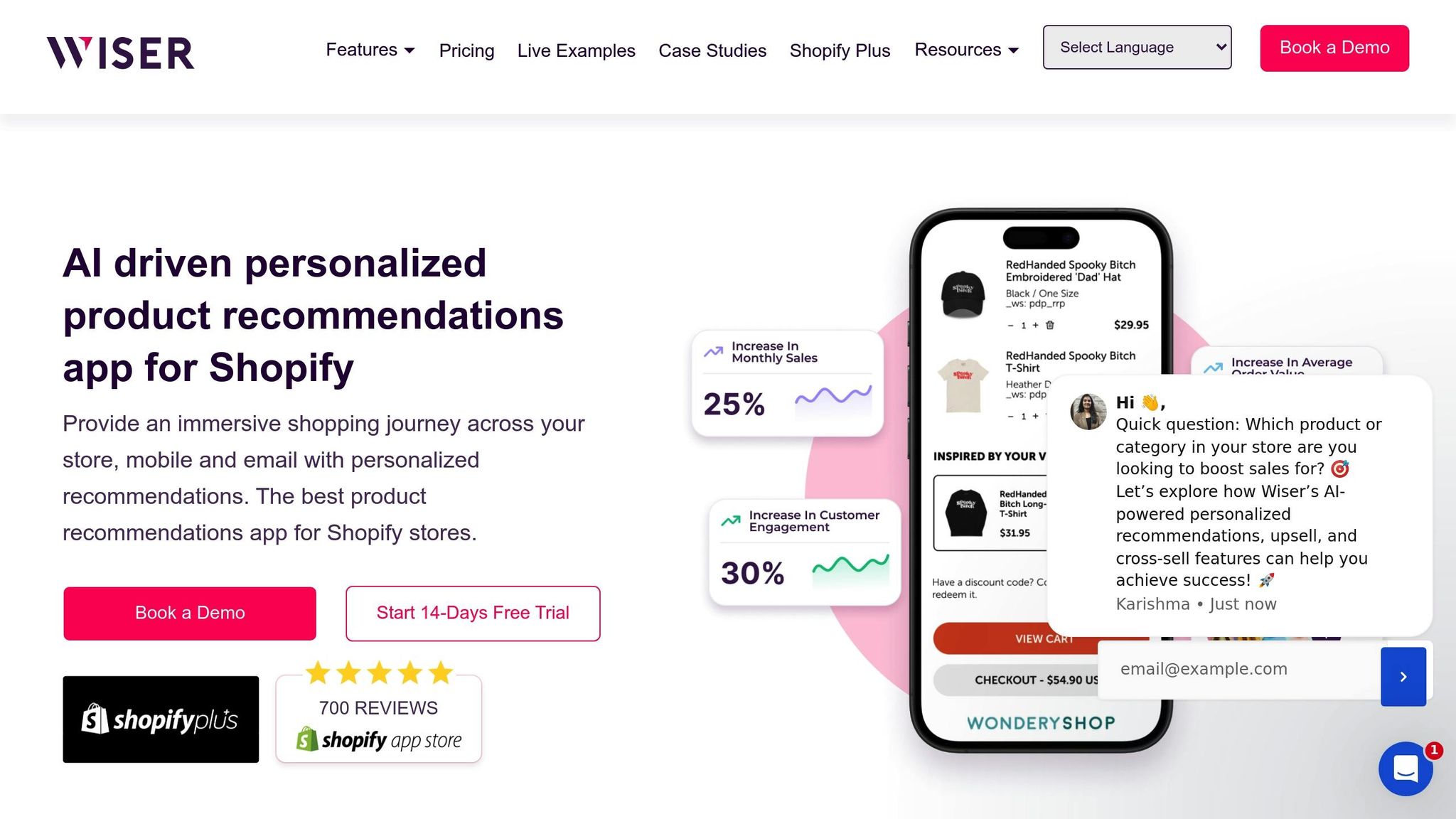
WISER is an AI-powered recommendation engine designed to enhance customer engagement. It offers a free plan for stores with up to 50 monthly orders and scales up to NZ$399 for businesses handling 3,001–5,000 orders [15].
AI-Driven Personalisation for Better Conversions
By analysing browsing and purchase data, WISER provides tailored recommendations through widgets like "Frequently Bought Together", "Related Products", and "Recently Viewed." These AI-driven suggestions can lead to up to a 20% increase in conversion rates and a 30% boost in average order values [14][15].
Upselling Across Multiple Touchpoints
WISER takes upselling to the next level by integrating its recommendations into various customer touchpoints. These include cart drawers, thank-you pages, targeted pop-ups, and post-purchase screens. For New Zealand businesses aiming to maximise customer value, this comprehensive strategy ensures no revenue opportunity is overlooked [15].
Additionally, WISER works seamlessly with email marketing tools like Klaviyo and Mailchimp, enabling merchants to bring personalisation into their email campaigns [15].
What Users Are Saying
With a 4.9-star rating from 414 reviews, WISER has received strong feedback from its users [16]. One merchant shared:
"Wiser is a great app with great customer support. They worked with us to carefully design each module in alignment with our site theme and are super responsive whenever we had an issue." [17]
However, not all feedback is glowing. A user highlighted some limitations:
"Very good app with plenty of valuable features. Wish the cart drawer upsell didn't require manual code and was also available in the free version instead of a paid subscription. Despite that, the free plan under 50 orders per month is very reasonable. Overall a must-have for any store." [17]
Setting Up for New Zealand Stores
To get started, install WISER from the Shopify App Store and customise its recommendation widgets to align with your brand’s look and feel. The platform also offers analytics to fine-tune your strategy over time [15].
For New Zealand merchants, this data-driven approach is especially useful for adapting to local shopping preferences while staying competitive globally. WISER's AI continuously learns from customer interactions, refining its recommendations to improve profitability [15].
Next, we’ll explore how Boost Commerce offers a different take on AI-driven solutions.
sbb-itb-f46a14b
5. Boost Commerce
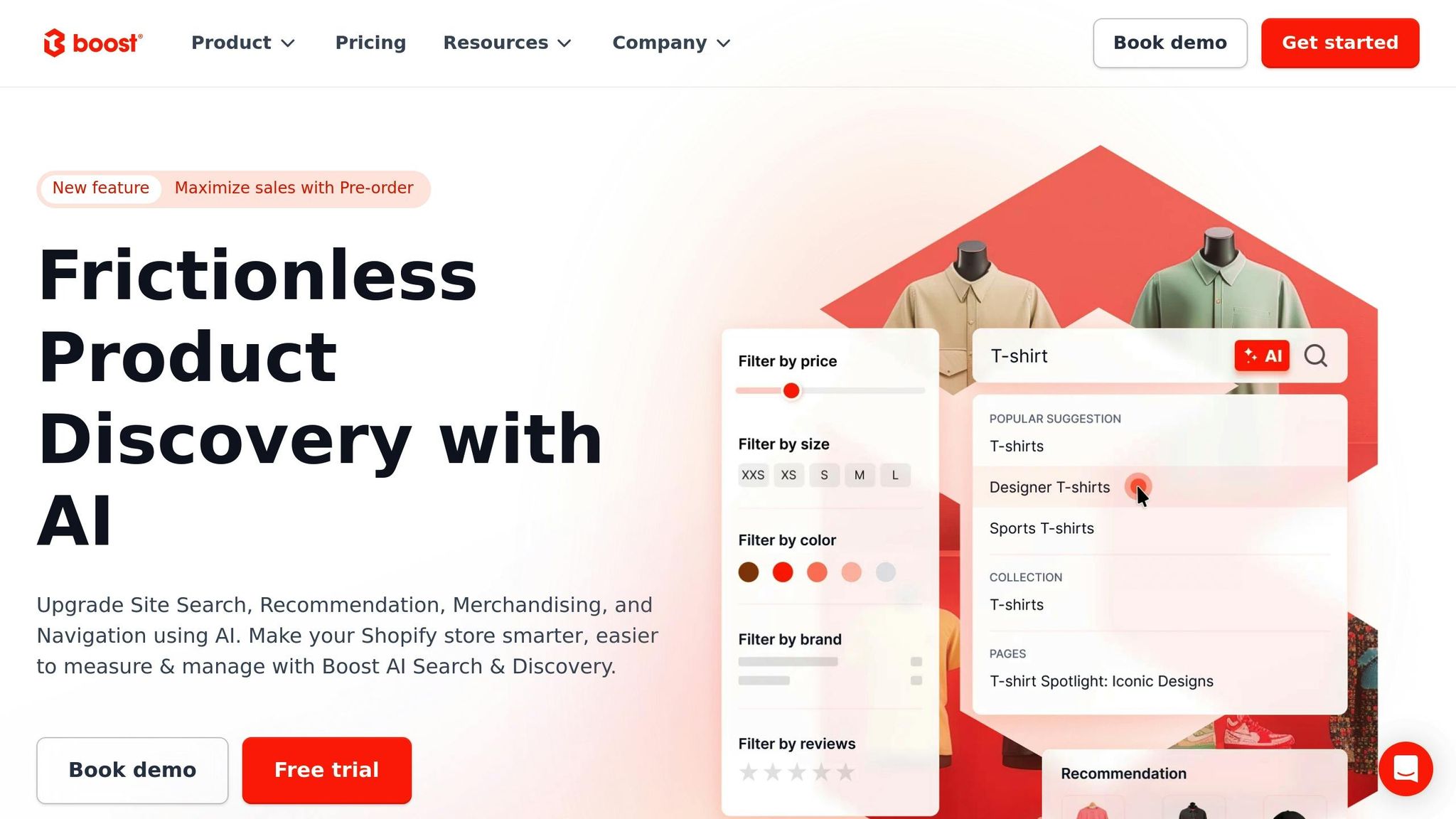
Boost Commerce is an AI-driven search and discovery platform designed to enhance product discovery for Shopify stores. With over 14,000 brands relying on its features and generating more than $16 billion in sales, it has carved out a strong position in the competitive e-commerce world [23][24].
Smarter Search for Better Performance
Shopify's built-in search functionality is fairly basic, but Boost Commerce takes it to the next level with personalised search, semantic search, and predictive search capabilities that truly understand customer intent [24]. Unlike Shopify's native search, which limits recommendation blocks to one per type, Boost Commerce allows unlimited blocks per page - offering a far more dynamic browsing experience [24]. This is particularly relevant for New Zealand shoppers, who value efficiency when browsing online.
For Kiwi merchants, this advanced search is a game-changer. With 66% of New Zealand shoppers researching online before buying in-store [20], and the average transaction value expected to drop by 7.5% in 2024 as consumers prioritise value, intelligent search tools that connect customers with the right products quickly are more important than ever [21].
Merchandising Features That Deliver Results
Boost Commerce offers powerful merchandising tools that give merchants precise control over product visibility [24]. In April 2025, the platform upgraded its Merchandising feature, increasing the number of products that can be pinned from 7 to 20, enabling even greater flexibility in product placement [18]. These tools are designed to help retailers optimise their revenue strategies.
One standout feature is the platform's predictive product bundles, which can increase average order value (AOV) by more than 20% - a vital tool for New Zealand retailers navigating declining transaction values [23]. Additionally, the introduction of volume discount bundles in April 2025 encourages bulk purchases, further boosting AOV [18].
Expanding Horizons with Global Selling
Boost Commerce's Global Selling feature, launched in March 2025, helps New Zealand merchants expand internationally by syncing Shopify Markets settings and translating storefront labels for global audiences [18]. With the local e-commerce market projected to reach $7.5 billion USD by the end of 2025, this feature positions Kiwi businesses to compete on a global scale [18][20].
The platform also ensures that prices are automatically formatted in NZD, complete with proper spacing and separators, simplifying international transactions for New Zealand merchants [22].
Flexible Pricing to Meet Different Needs
Boost Commerce offers a range of pricing plans to suit businesses of all sizes. For smaller stores with up to 25 products, there’s a free plan. Paid plans start at $29/month for Basic, go up to $239/month for Essential, and top out at $399/month for Professional. For larger operations, there’s an Enterprise plan with custom pricing [18][19].
Merchant Feedback
The platform has earned a 4.7-star rating on the Shopify App Store, with users frequently praising its functionality and support [19]. George Greenhill shared:
"Boost's support is second to none. All matters are handled quickly with genuine fixes instead of half-hearted workarounds you get from many other businesses that list Shopify apps." [23]
Another user, Morgan Moreira, highlighted the thorough research behind their decision:
"We did a lot of research on this. We read tons of reviews from actual app users, tons of comments about one vs another, and we also tested quite a few. We found Product Filter & Search to be the most powerful and flexible of all." [23]
Seamless Integration and Actionable Analytics
Boost Commerce integrates smoothly with popular tools like Klaviyo, REVIEWS.io, Yotpo, and Judge.me [18]. Its integration with Klaviyo alone can boost email conversions by up to 20% [23]. The platform also provides detailed analytics, offering insights into shopper behaviour and ROI, helping Kiwi merchants make smarter, data-driven decisions in a competitive market [23].
Additionally, Shopify Flow offers a unique approach to automating workflows, complementing Boost Commerce's capabilities.
6. Shopify Flow
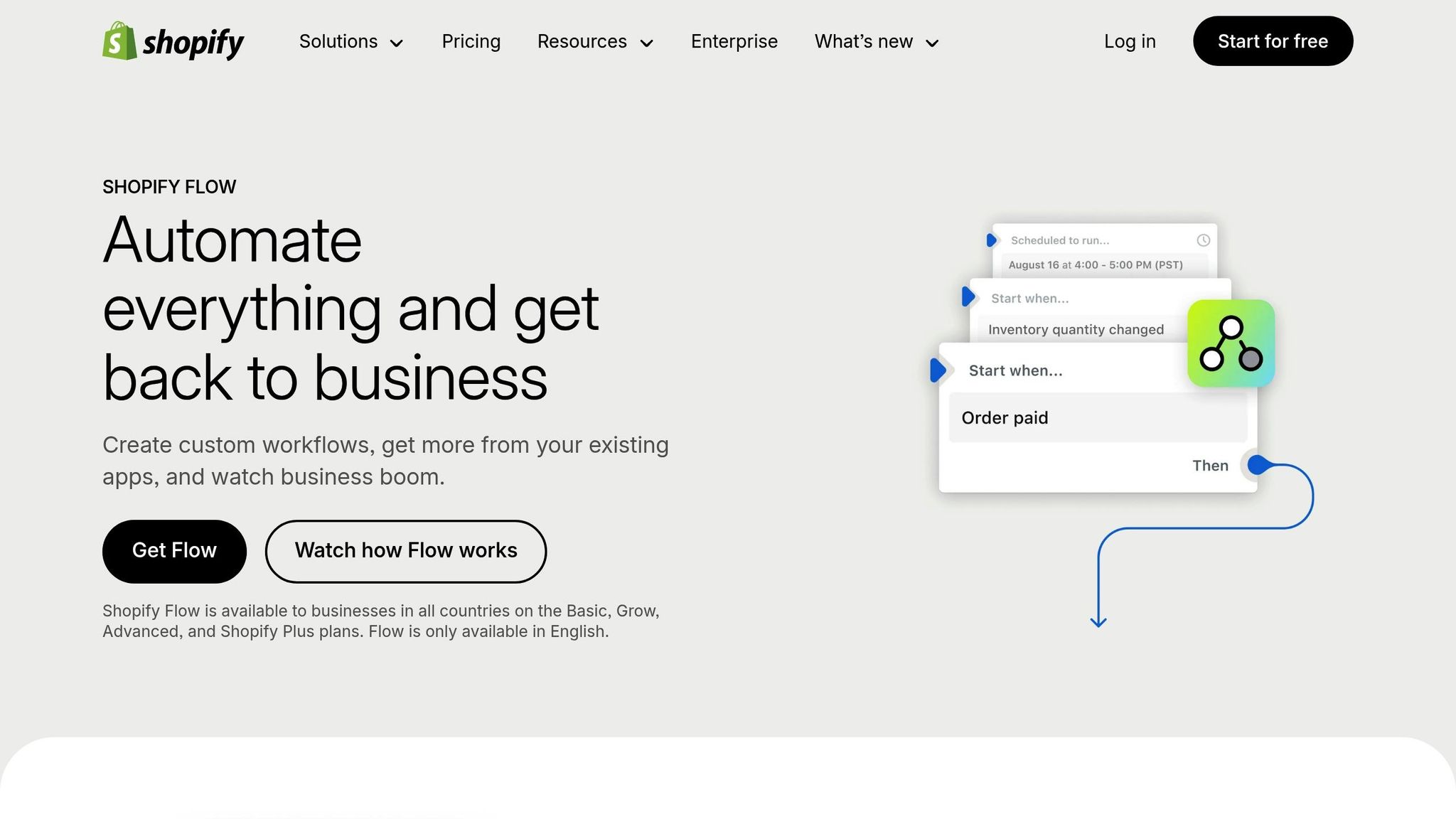
Shopify Flow is Shopify's built-in automation tool designed to handle repetitive tasks for merchants in New Zealand. It's available at no extra cost across the Basic, Grow, Advanced, and Shopify Plus plans [28].
Built for High-Performance Demands
Shopify Flow has proven its ability to handle massive workloads. For instance, during Black Friday Cyber Monday, it processed an impressive 562 million workflows. On a monthly basis, it automates 1 billion decisions and runs 22,000 jobs [25]. This level of efficiency is especially valuable for New Zealand retailers during busy times like Boxing Day sales or back-to-school shopping periods.
Easy-to-Use Workflow Builder
The platform operates on a "trigger, condition, and action" model, making it accessible even for those without coding skills [25]. Its visual workflow builder allows merchants to automate tasks such as tagging VIP customers, managing stock levels, or flagging potentially fraudulent orders. This flexibility helps businesses streamline operations that would otherwise require manual effort, saving time and resources.
Success Stories from New Zealand
A great example of Shopify Flow in action is Sealord, a New Zealand fertiliser brand. They’ve used the tool to automate their email marketing campaigns. For instance, they’ve set up workflows to send thank-you emails to customers who redeem a welcome coupon and follow-up reminders to those who haven’t used their coupon within five days [27]. This kind of targeted automation not only boosts conversion rates but also reduces the need for manual follow-ups.
Many New Zealand businesses report that the time saved through automation is reinvested into other critical areas, such as improving ecommerce strategies, fine-tuning shipping processes, or creating more engaging content for customers.
Seamless Integration with Shopify
Because Shopify Flow is fully integrated into the Shopify admin, it has real-time access to store data and works seamlessly with other Shopify apps [28]. This integration ensures that workflows can instantly respond to changes, whether it’s a stock update, an order status change, or customer behaviour. For example, automations like sending order shipment notifications can help build customer trust and loyalty.
How to Get Started
To begin using Shopify Flow, merchants should first identify repetitive tasks and review their current workflows for inefficiencies [26]. Shopify Flow offers pre-built templates that can serve as a helpful starting point, but customisation is often necessary to meet specific business needs [30][31]. Testing each workflow thoroughly before activating it is essential to ensure everything runs smoothly [26][30].
Although Shopify Flow has a 3.7-star rating on the Shopify App Store, it remains a reliable tool for many merchants. Some users have noted limitations, such as its lack of dynamic tagging compared to more specialised tools [28][29]. Despite this, its ease of use, deep integration, and cost-free access make it an appealing choice for New Zealand merchants aiming to automate tasks and focus on growing their businesses strategically.
Features and Limitations
The tools you choose for your Shopify store can greatly influence its performance. By understanding the strengths and trade-offs of each tool, you can make smarter decisions that align with your business goals and budget.
Let’s start with marketing automation. Tools like Klaviyo and ActiveCampaign bring powerful features to the table. Klaviyo's predictive analytics, for example, can recover up to 35% of lost sales using its 'Viewed Product' flow [34]. Meanwhile, ActiveCampaign boasts over 500 pre-built workflows, helping businesses achieve a 20% reactivation rate [32]. However, these advanced features come at a cost, with pricing ranging from NZ$45 to NZ$149 per month [32][35].
When it comes to inventory management, tools vary significantly in their approach. Inventory issues are a major concern for e-commerce businesses, costing billions annually, with over 70% of retailers struggling due to outdated systems [33]. Some tools, like Wiser (starting at just NZ$9 per month), are designed specifically for inventory optimisation. On the other hand, Shopify Flow offers inventory management as part of its broader automation capabilities, included at no extra cost [35].
For Kiwi merchants, integration complexity can make or break a tool's usefulness. Shopify Flow, being a built-in solution, provides instant access to real-time store data. Many third-party tools, while offering specialised features, often require additional setup and may face delays in data synchronisation - something to consider if timely updates are critical for your business.
Pricing structures also vary widely, giving merchants plenty of options depending on their needs and budget. For instance, MailerLite offers a free plan for up to 1,000 subscribers (with a limit of 12,000 monthly emails), while its paid plans, like NZ$50 for 10,000 subscribers, remain affordable [32]. Mid-tier options like Omnisend, which combines email and SMS features, cost around NZ$59 monthly for 1,000 contacts [32]. On the higher end, enterprise tools such as Polar Analytics and Icon start at NZ$300 and NZ$399 per month, respectively [35].
| Tool Category | Strengths | Limitations | NZ Pricing (Monthly) |
|---|---|---|---|
| Marketing Automation | Predictive analytics, segmentation | High learning curve, premium cost | NZ$45–NZ$149 |
| Inventory Management | Real-time syncing, fewer errors | Limited marketing features | NZ$9–NZ$300 |
| Built-in Solutions | Seamless integration, no extra cost | Fewer specialised features | Free with Shopify |
| Multi-channel Platforms | Comprehensive feature sets | Complex setup, higher costs | NZ$59–NZ$499 |
Other factors also play a role in how effective a tool might be for your store. Customer support availability is one such consideration. While established platforms often provide 24/7 support, budget-friendly or newer tools may only offer assistance during standard New Zealand business hours. This can be a problem during peak sales periods, like Boxing Day, when immediate help is crucial.
Scalability is another aspect to think about. Some tools, like LeftBrain, use tiered pricing that increases with your contact list size - costing NZ$200 for 10,000 contacts [32]. Others follow transaction-based pricing, which can become expensive as your sales grow.
Shopify Flow stands out for its simplicity, offering a visual builder that lets you create automations without needing any coding skills. However, if you need more advanced functionality, third-party platforms can deliver - but often with a steeper learning curve.
Finally, there’s the issue of data ownership and portability. Some third-party tools make it tricky to export customer data or move to a different platform, potentially locking you in. Even Shopify itself can have limitations in this regard [37].
For New Zealand businesses, the key is finding a balance. Starting with affordable, straightforward tools and upgrading as your store grows is often a more sustainable approach than jumping straight into costly enterprise solutions [33][34].
Tool Selection Guide
In New Zealand, where seasonal trading patterns and unique consumer preferences play a big role, picking the right automation tool is crucial. The choice largely depends on your business size, industry, and specific operational challenges. Here’s a breakdown to help you match tools to your needs.
Small Kiwi businesses can start with simple, built-in options like Shopify Flow. This tool offers free features such as inventory alerts and order processing. Pair it with Shopify Admin to set reorder points and avoid stock shortages during peak times like Christmas and Boxing Day [38]. Small retailers should also look at their fulfilment processes to identify manual tasks - like data entry or stock counting - that can be automated for efficiency [1].
Medium-sized businesses often face more complex operations and can benefit from upgrading to Shopify Advanced (around NZ$450 per month when billed annually). Adding tools like Wiser for inventory optimisation (starting at NZ$9 monthly) can further streamline operations. It’s important to choose tools that integrate smoothly with your ERP, POS, and ecommerce platforms to enable real-time data sharing [40]. A great example is Oak + Fort, which saved 50 staff hours per week and reduced operating costs by 47% after centralising inventory management [39].
Large enterprises will need more robust solutions. Combining Shopify Plus (starting at around NZ$3,000 per month [36]) with enterprise-grade tools like Polar Analytics (approximately NZ$450 monthly) provides advanced reporting and priority support [35]. Automation at this level can cut business process costs by 25%–40% [6]. With nearly 70% of carts abandoned, automated recovery becomes critical. Statistics show that one in five cart abandonment emails gets a click, and 11% of those clicks convert into purchases [43].
| Business Size | Recommended Starting Point | Monthly Budget Range | Key Focus Areas |
|---|---|---|---|
| Small (0–50 orders/day) | Shopify Flow + built-in tools | NZ$0 – NZ$50 | Inventory alerts, basic order automation |
| Medium (50–500 orders/day) | Shopify Advanced + specialised tools | NZ$450 – NZ$900 | Multi-channel integration, advanced reporting |
| Large (500+ orders/day) | Shopify Plus + enterprise solutions | Starting at NZ$3,000+ | Predictive analytics, complex workflows |
Industry-specific needs also matter. For instance, fashion retailers like Rebecca Minkoff use RFID tags to achieve 99% inventory accuracy, far outperforming manual methods [39].
Local nuances, such as New Zealanders’ preference for homegrown brands, make features like customer reviews and region-specific marketing tools essential for building trust [36].
The way you implement automation is just as important as the tools you choose. Start small - focus on automating one key area first and then expand gradually [42]. Set clear goals, train your team thoroughly, and monitor performance regularly to address inefficiencies [41] [42].
FAQs
How can I choose the right Shopify automation tool for my e-commerce business in New Zealand?
Choosing the Right Shopify Automation Tool for Your New Zealand Business
Picking the perfect Shopify automation tool for your business in New Zealand starts with figuring out which tasks you want to make easier. Think about areas like inventory management, order processing, or marketing campaigns - these are often the first places where automation can make a big difference.
The right tool should match your business’s size and goals. For instance, automation can handle repetitive tasks like restocking inventory, managing a surge of orders during busy seasons, or sending tailored marketing emails to your customers. By letting automation take care of these day-to-day jobs, you’ll free up time, cut down on costs, and have more energy to focus on growing your brand.
Make sure any tool you choose works smoothly with your current Shopify setup and caters to local requirements, like pricing in New Zealand dollars (NZD) and compliance with GST. The ideal tool will not only simplify your processes but also help you provide a better experience for your customers.
How can AI-powered tools improve customer engagement and help shoppers discover products more easily?
AI-driven tools are transforming the way customers interact with brands, especially when it comes to engagement and discovering products. By offering tailored recommendations based on individual preferences and shopping habits, these tools make the experience feel personal. Advanced machine learning algorithms dig into data like browsing history and past purchases to suggest items that genuinely match what a customer might want. The result? Higher chances of turning browsers into buyers and a shopping journey that feels seamless and enjoyable.
These tools also take the hassle out of searching. They make the process quicker and more intuitive, helping customers find exactly what they need without frustration. This not only boosts satisfaction but also builds a sense of trust and loyalty, encouraging shoppers to return again and again.
Is Shopify Flow suitable for managing complex workflows in large businesses, and how well does it work with other Shopify apps?
Shopify Flow is built to handle intricate workflows, making it a solid option for larger businesses. It lets you automate a range of tasks like order processing, inventory management, and customer segmentation, simplifying operations for businesses dealing with high transaction volumes.
It also works effortlessly with other Shopify apps and supported third-party tools, allowing you to craft tailored workflows based on specific triggers and conditions. This doesn’t just boost efficiency - it also ensures your operations can scale smoothly as your business expands.
Heading 1
Heading 2
Heading 3
Heading 4
Heading 5
Heading 6
Lorem ipsum dolor sit amet, consectetur adipiscing elit, sed do eiusmod tempor incididunt ut labore et dolore magna aliqua. Ut enim ad minim veniam, quis nostrud exercitation ullamco laboris nisi ut aliquip ex ea commodo consequat. Duis aute irure dolor in reprehenderit in voluptate velit esse cillum dolore eu fugiat nulla pariatur.
Block quote
Ordered list
- Item 1
- Item 2
- Item 3
Unordered list
- Item A
- Item B
- Item C
Bold text
Emphasis
Superscript
Subscript




